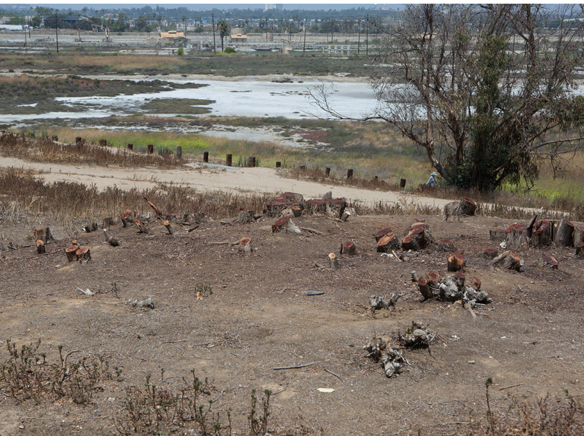Third in a series on Gum Grove Park.
Gum Grove Park, which is city-owned, is host to a wide array of plant life, primarily among them blue gum eucalyptus trees. Many trees (and possibly shrubs) were removed without city permission five years ago. The removal led to a lawsuit, and a settlement.
A city project to strengthen and diversify the ecology of the park by planting several oaks in their place has been underway for some time but was recently delayed by the state government.
The largest hole visible at the entrance to the park and surrounded by chain link fence is a hole that the city lawfully dug before the work had to be stopped. (Illegal digging by members of the public was covered in the first installment of this series, “Gum Grove: illegal digging and biking ramps up tensions in the park.” The story is online at sunnews.org.)
In part, worries about indigenous people’s concerns for preserving Gum Grove Park’s cultural heritage have stalled the local effort to re-plant.
In addition, city officials are still working with authorities to get an application for development approved by the California Coastal Commission.
“The work for such commenced several months ago,” wrote Les Johnson, Community Development director for Seal Beach, about the potential tree planting.
However, “it was quickly discovered that the work being performed was within a culturally sensitive area as identified by the Gabrielino,” Johnson wrote.
“As a result, we stopped all work,” said Johnson.
He also said the Coastal Commission requires the city to have a Coastal Development Permit for the project.
Johnson said the city submitted an application in early January.
The city has since resubmitted a planting plan for coastal development to the CCC and the project remains on hold.
The hope is “that a permit will be issued in April and we can proceed with the tree plantings,” wrote Johnson in an email. (In a March 8 email to the Sun, Johnson put the time frame for planting the trees within 60 to 90 days.)
According to the city, funds received in a 2017 settlement with the resident who chopped down those trees will be used for the replanting.
Interestingly enough, when a native Gabrielino burial ground was found while laying the foundations of the Heron Pointe neighborhood several years ago, one plan was to move the site, remains and all, to Gum Grove, according to a 2003 Los Angeles Times article.
Matthew Teutimez is part of a group of Gabrielino descendants who feel it is their mission not to stop such projects from moving forward but to put a plan in place should cultural resources or remains be found in the process.
With a master’s in biology from California State University, Long Beach and 20 years of experience in the field, he sees no issue with planting indigenous trees to bolster the ecology of the place.
“We’re [just] here to protect these last remaining resources of our culture,” Teutimez said.
“Once these are gone, it’s gone forever,” he said, “and these resources are older than Roman culture, older than the Egyptian culture, older than all these cultures we’re taught about in school.”
Indigenous people have occupied this area “13,000 plus years, so why aren’t we looking out for the culture that is under our own feet?” he asked.
He also said that the “majority of our waterways are all scattered with burials” so there is a high likelihood that a contingency plan needs to be in place before replanting can resume.




